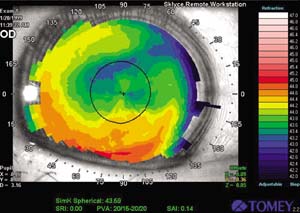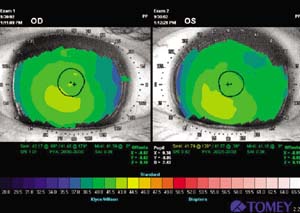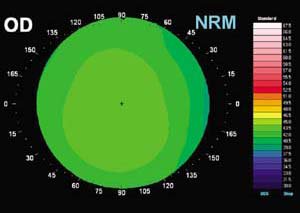Corneal topography pearls help practices become ‘plaintiff-free zones’
Keratectasia following LASIK may lead to litigation; contact lenses may distort topography.
WAILEA, Hawaii – With all the focus on wavefront technology over the past 3 years, many physicians appear to have forgotten some of the basic tenets of corneal topography analysis, according to a speaker here.
“Legal cases develop occasionally when corneal pathology is missed preoperatively during screening,” said Stephen D. Klyce, PhD, a professor of ophthalmology at Louisiana State University.
Purchasing the right corneal topographer is paramount.
“Machines range in cost from $8,000 to about $40,000, but the most expensive device isn’t necessarily the best for any one individual. I encourage you to talk to your colleagues about their success in using the various machines,” Dr. Klyce said at Hawaii 2003: the Royal Hawaiian Eye Meeting.
The Nidek Magellan is one of the newest topographers.
“It is a very basic corneal topographer, with a major advantage of extreme accuracy. The 30-ring projector has a dual-edge ring finder so that a total of 60 rings can be detected,” he said.
Use well
Seven topography pearls | |
|
Regardless of the topographer chosen, physicians need to know how to properly set up and use their system.
“The continued clinical use of self-adapting scales is alarming,” Dr. Klyce said. “It is easy to become very confused over what is pathology and what isn’t pathology, unless you are able to set up your machine with a good, fixed, standard scale that you can interpret.”
Dr. Klyce recommends using the axial power map for routine clinical examinations.
“Useful fixed-interval and contrasting-color scales have been published and are freely available in the literature,” he said.
Information presented also needs to be simple enough for practical use.
“Sometimes it seems as though it could take several years and a PhD to really be able to use some of the information. Don’t collect and put in the chart information you don’t understand or use,” he said.
For example, a preop posterior corneal elevation map may show a steep, red area.
“If the cornea develops instability post-LASIK, can you testify this map was normal? It might be, but ‘might’ is never good enough in court. Reputable topographers will provide details for normal ranges of measurements,” he said.
Checking the calibration is important as well.
“An inadvertent jolt can lead to inaccurate measurements,” he said.
For instance, one night the cleaning crew accidentally bumped a topographer.
“For that entire week, everyone who came into that clinic had what looked like a keratoconus suspect-type cornea. Remember, normal and pathologic eyes usually show non-superimposible mirror image symmetry,” he said.
Hallmarks
The basic hallmarks of corneal topography should also be remembered.
“The normal cornea has very little detail in the center over the pupil, and flattens toward the periphery with very smooth contours,” Dr. Klyce said. “Anything else is abnormal, and it’s up to you to discover what that abnormality is.”
A good rule of thumb is to consider K readings abnormal if they are less than 38 or greater than 47.5 D.
“We all should be able to recognize different stages of keratoconus. It is also very important to recognize the ‘C’ or claw-shaped pattern which is characteristic of pellucid marginal degeneration,” he said.
These corneas can develop keratectasia after LASIK.
“Unfortunately, there are many cases in the courts now of keratectasia following LASIK,” he said.
Dr. Klyce shared the example of basement membrane dystrophy, with irregular contours in the corneal topography.
“This patient went on to LASIK, and now has severe keratectasia, and will have to undergo a corneal transplant,” he said. “You don’t have to be able to diagnose the condition; you simply need to know it is not normal topography. Then you must look further to make sure you’re not doing a disservice to yourself and, of course, to your patient.”
|
Contact lenses
Contact lenses produce changes in the corneal surface.
“If the patient is wearing contact lenses, you have to wait until the topography relaxes to a normal shape,” Dr. Klyce said. “This normally takes 3 weeks, but may take up to 6 months. By not knowing the final refraction, the patient is going to have an error after refractive surgery.”
Finally, always examine both eyes.
“One eye might look perfectly normal while the other eye is pathological. The pathology in one eye often forecasts emerging pathology in the other eye,” he said.
For instance, a candidate for LASIK may have latent keratoconus in the fellow eye, which after surgery might develop into keratectasia.
“I hope these pearls will help build a plaintiff-free zone around your practice,” Dr. Klyce said. “No matter how powerful wavefront sensors may eventually become, they will never be able to uniquely identify pathology associated with the cornea. With the increasing number of LASIK litigations, the need for adequate screening with corneal topography has never been greater.”
For Your Information:
- Stephen D. Klyce, PhD, can be reached at LSU Eye Center, Suite B, 2020 Gravier St., New Orleans, LA 70112; (504) 412-1329; fax: (504) 412-1315; e-mail: sklyce@klyce.com. Dr. Klyce has no direct financial interest in the products mentioned in this article. He is a paid consultant for Nidek.




